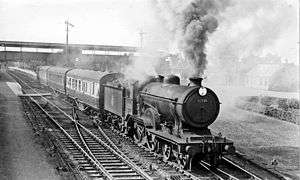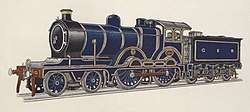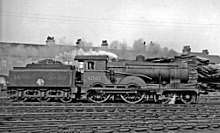GER Classes S46, D56 and H88
The GER Classes S46, D56 and H88 (classified Classes D14, D15, and D16 by the London and North Eastern Railway) were three classes of similar 4-4-0 steam locomotive designed by James Holden (S46 and D56) and A. J. Hill (H88) for the Great Eastern Railway.
| GER S46, D56 and H88 "Claud Hamilton" LNER Class D14/D15/D16 | |||||||||||||||||||||||||||||
|---|---|---|---|---|---|---|---|---|---|---|---|---|---|---|---|---|---|---|---|---|---|---|---|---|---|---|---|---|---|
 D16/3 'Super Claud' 4-4-0 No. 62530 departs March in August 1958. | |||||||||||||||||||||||||||||
| |||||||||||||||||||||||||||||
| |||||||||||||||||||||||||||||
| |||||||||||||||||||||||||||||
| |||||||||||||||||||||||||||||
They were given the nickname Claud Hamilton after the pioneer engine of the class, named after Lord Claud Hamilton (1843–1925) the chairman of the Great Eastern Railway. The D56 class of 1903-4 evolved the design to include a square-topped Belpaire firebox. The H88 class of 1923 featured a larger superheated boiler, leading them to be known as Super Clauds. Many earlier members of the class were rebuilt during their working life.
During the Edwardian era, they were the flagship express locomotive on the Great Eastern Main Line, and although displaced on the heaviest express trains by the larger S69 class from 1911 (itself a 4-6-0 development of the Claud design), members of the class were used on passenger and goods services throughout the Eastern Region until 1960. No locomotives of the three classes survived to preservation.
Design

The Claud Hamilton, particularly in its original GER blue livery, is widely considered one of the most elegant locomotive designs of the pre-grouping era.[1]
In his 1955 history of the Great Eastern Railway, Cecil J. Allen devotes a whole chapter to the class and noted that
Of all the locomotive designs that emerged from Stratford Works during the reign of James Holden, the one destined to achieve the greatest fame, beyond question, was his Claud Hamilton type 4-4-0, of which the pioneer example, No. 1900 Claud Hamilton, took the rails in 1900.[2]
Although credited to James Holden, the Locomotive Superintendent of the Great Eastern, Frederick Vernon Russell (Holden's Chief Designer) is thought to have contributed substantially to the design of the Claud Hamiltons; while researching his Some Classic Locomotives of 1949, C.H. Ellis was informed by Russell that during the process of designing the locomotive "Mr Holden, by then a valetudinarian was making a long recuperative stay in Egypt."[3]
The 4-4-0 inside cylinder locomotive included a number of features that were to appear on later Great Eastern locomotive classes, including a circular polished steel smokebox door surround (instead of the usual horizontal straps) and decorative splashers.[2] Class pioneer No 1900 Claud Hamilton featuring red lining and connecting rods, copper chimney cap and GER coat of arms was much admired when it was exhibited at the 1900 Paris Exposition.[4]
The original S46 boiler had 1,630 sq ft (151 m2) of heating surface, with a 21.3 sq ft (1.98 m2) grate. The cylinders were 19 x 26 in. with flat valves placed below, operated by Stephenson's motion. The coupled wheels were 7 ft (2.1 m) in diameter.
Allen reports that Claud Hamiltons in their original state were capable of taking around 350 tons from Liverpool Street to North Walsham in under the booked time. No. 1882 with round-top boiler ran the 130.2 miles (209.5 km) in 156 min 60 sec. Even heavier trains were managed in the up direction: No. 1809 (Belpaire boiler) took 400 tons up in 157 minutes 24 seconds.
The S46 design was substantially modified in later incarnations, particularly with the introduction of a larger superheated boiler on the H88 designed by Alfred John Hill. Most earlier members of the class were substantially modified by Hill or during the tenure of Sir Nigel Gresley as CME of the LNER from 1923.[5]
Two separate classes were also developed from the design of the Claud Hamilton; Holden's Class F48 (constructed between 1900 and 1903) was essentially an 0-6-0 goods version of the S46[6] and the Class S69 (built between 1911 and 1921) was a larger 4-6-0 version using many of the same design cues as the H88, built to replace the Clauds on the heaviest express trains.
Classification and numbering


The classification of the Claud Hamiltons is complex but is summarised here:
- GER Class S46 (LNER Class D14), 4 ft 9 in diameter boiler, round-top firebox[7]
- GER Class D56 (LNER Class D15), 4 ft 9 in diameter boiler, Belpaire firebox[7]
- LNER Class D15/1, D15 as built with short smokebox, some with superheater
- LNER Class D15/2, D15 with superheater and long smokebox
- GER Class H88 (LNER Class D16), "Super Claud" with superheater, larger boiler (5 ft 1 1⁄8 in diameter) and Belpaire firebox[7]
- LNER Class D16/1, D16 as built (with short smokebox)
- LNER Class D16/2, as D16/1 but with extended smokebox
- LNER Class D16/3, Gresley rebuild of D15 and D16 with round-top firebox, some with piston valves
The class pioneer was numbered 1900 (to coincide with the year the locomotive was built), with subsequent batches numbered backwards in tens as follows:
| Year | Order | Quantity | GER Nos. | LNER Nos. | 1946 Nos. | Notes |
|---|---|---|---|---|---|---|
| 1900 | S46 | 1 | 1900 | 8900 | 2500 | |
| 1900 | L47 | 10 | 1890–1899 | 8890–8899 | 2501–2510 | |
| 1901 | M51 | 10 | 1880–1889 | 8880–8889 | 2511–2520 | |
| 1902 | F53 | 10 | 1870–1879 | 8870–8879 | 2521–2530 | |
| 1903 | L55 | 10 | 1860–1869 | 8860–8869 | 2531–2540 | |
| 1903–04 | D56 | 10 | 1850–1859 | 8850–8859 | 2541–2550 | Belpaire boiler |
| 1906–07 | G61 | 10 | 1840–1849 | 8840–8849 | 2551–2560 | |
| 1908 | A64 | 10 | 1830–1839 | 8830–8839 | 2561–2570 | |
| 1909 | B66 | 10 | 1820–1829 | 8820–8829 | 2571–2580 | |
| 1910 | D67 | 10 | 1810–1819 | 8810–8819 | 2581–2590 | |
| 1910 | P67 | 10 | 1800–1809– | 8800–8809 | 2591–2600 | |
| 1911 | E69 | 10 | 1790–1799 | 8790–8799 | 2601–2610 | |
| 1923 | H88 | 10 | 1780–1789 | 8780–8789 | 2611–2620 | Never carried GER numbers in service |
The Railway Magazine of November 1923 includes the log of a run from Liverpool Street to Ipswich with 4-4-0 number 1780, so this loco at least must have carried a GER number.[10]
Appearance

Originally painted in GER blue with red lining and bronze highlights, following the 1923 grouping the GER became part of the London and North Eastern Railway, and were painted in the company's apple green with LNER on the tender and cab-side numbers. Side rods were polished steel. The appearance was altered when a larger boiler and Belpaire firebox was fitted, meaning a change in the cab window shape as well.[11]
8783 and 8787 were kept in immaculate condition as dedicated Royal locos for hauling the Royal Train from King's Cross to Wolferton (the nearest station for Sandringham House).[12] 8783 was also fitted with a copper-capped chimney. Later some locos carried numbers and London & North Eastern Railway on the tender. During the Second World War most were repainted into unlined black livery with the letters "N E" on the tender. "Royal Claud" 8783 retained its LNER apple green livery into British Railways days (after 1948), but with BRITISH RAILWAYS on the tender initially.
Others were painted black with BRITISH RAILWAYS on the tender. Later on they carried both lined and unlined black with the early BR crest and those which survived after 1956 lined and unlined black with the later crest. Many of the class retained steel smokebox door rings until withdrawal, except those rebuilt by Gresley with a larger boiler which also required a new smokebox. Many locos had their decorative valances removed in later years as well, though they still retained their distinctive character.
Accidents and incidents
- On 1 January 1915, locomotive No. 1813 was hauling an express passenger train that overran signals and collided with a local passenger train at Ilford, Essex. Ten people were killed and more than 500 were injured.[13]
- On 12 February 1927, locomotive No. 8808 was hauling an express passenger train that was in collision with a lorry on a level crossing at Tottenham, London. Due to foggy conditions, the train was not travelling at a high speed.[14]
- On 17 January 1931, locomotive No. 8781 was running light engine at Great Holland, Essex when it was in a head-on collision with a newspaper train. Two people were killed and two were seriously injured. The newspaper train had departed from Thorpe-le-Soken station against signals.[15]
- In November 1934, D16/2 8783 locomotive was derailed at Wormley, Hertfordshire when it collided with a lorry on a level crossing. Both engine crew were killed.[16]
- On 1 June 1939, locomotive No. 8783 was hauling a passenger train that collided with a lorry on an occupation crossing at Hilgay, Norfolk and was derailed. [17]
Withdrawals
Withdrawals of the class began in 1945, with the final member, a D16/3, scrapped in 1960 leaving no survivors of the class.
| Year | Quantity in service at start of year | Quantity withdrawn | Locomotive numbers | Notes |
|---|---|---|---|---|
| 1945 | 121 | 1 | 8866 | Not renumbered |
| 1946 | 120 | 2 | 2550/95 | |
| 1947 | 118 | 1 | 2500 | Name transferred to 2546 |
| 1948 | 117 | 6 | 2504/60/63/83, 2600/02 | |
| 1949 | 111 | 1 | 2594 | |
| 1950 | 110 | 3 | 62508/12/91 | |
| 1951 | 107 | 7 | 62501/03/05/20/28/47, 62603 | |
| 1952 | 100 | 8 | 62502/06-07/09/27/38/90/98 | |
| 1953 | 92 | 2 | 62581, 62616 | |
| 1955 | 90 | 15 | 62525/31/36/41/49/52/54/57/59/73–74/79/85, 62607/20 | |
| 1956 | 75 | 8 | 62523/32/42/51/67/69/77/87 | |
| 1957 | 67 | 28 | 62510/14/16/19/26/33/35/39/46/48/53/56/58/62/65/75–76/78/84/93/96, 62601/05/08–09/11/17/19 | |
| 1958 | 39 | 23 | 62513/15/18/21–22/30/34/43/45/55/61/64/66/68/72/80/86/88/92/99, 62610/14–15 | |
| 1959 | 16 | 12 | 62511/17/29/40/44/70–71/82/89, 62606/12/18 | |
| 1960 | 4 | 4 | 62524/97, 62604/13 | |
Revival
A group based at the Whitwell & Reepham railway plan to build a replica of D16/2 No. 8783 to be named Phoenix.[19]
In fiction
The design was the basis of the character Molly in the children's TV series Thomas the Tank Engine and Friends.[20]
References
- "The Holden 'Claud Hamilton' Class D14, D15, & D16 4-4-0 Locomotives". LNER Encyclopedia. Retrieved 27 May 2019.
- Allen 1955, p. 127.
- Ellis 1965, p. 61.
- Allen 1955, p. 130.
- Fry et al. 1981, pp. 1, 3, 18–21.
- Aldrich 1969, p. 71.
- Fry et al. 1981, p. 20.
- Fry et al. 1981, pp. 19, 53–55.
- Baxter 2012, pp. 59–67, 105–106.
- Allen 1923, p. 398.
- Allen 1955, pp. 129-130.
- Jenkinson, Edgington & Smart 1994, p. 78.
- Earnshaw 1991, p. 16.
- Earnshaw 1990, p. 16.
- Vaughan 1989, pp. 69-73.
- Trevena 1980, pp. 36-37.
- Earnshaw 1990, p. 21.
- Fry et al. 1981, pp. 53–55.
- "Claud Hamilton Locomotive Group". Claud Hamilton Locomotive Group. Retrieved 14 October 2016.
- "Molly - Character Profile & Bio". Thomas & Friends - Official Website. Retrieved 31 July 2019.
Bibliography
- Aldrich, C. Langley (1969). The Locomotives of the Great Eastern Railway 1862–1962 (7th ed.). Wickford, Essex: C. Langley Aldrich. OCLC 30278831.
- Allen, Cecil J. (November 1923). "British Locomotive Practice and Performance". The Railway Magazine. Vol. 53 no. 313. pp. 385–400.CS1 maint: ref=harv (link)
- Allen, Cecil J. (1955). The Great Eastern Railway. Shepperton: Ian Allen. ISBN 9780711006591.CS1 maint: ref=harv (link)
- Baxter, Bertram (2012). Baxter, David; Mitchell, Peter (eds.). British Locomotive Catalogue 1825–1923, Volume 6: Great Eastern Railway, North British Railway, Great North of Scotland Railway, Midland & Great Northern Joint Railway, remaining companies in the LNER group. Southampton: Kestrel Railway Books. ISBN 978-1-905505-26-5.
- Earnshaw, Alan (1990). Trains in Trouble: Vol. 6. Penryn: Atlantic Books. ISBN 0-906899-37-0.CS1 maint: ref=harv (link)
- Earnshaw, Alan (1991). Trains in Trouble: Vol. 7. Penryn: Atlantic Books. ISBN 0-906899-50-8.CS1 maint: ref=harv (link)
- Ellis, C.H. (1942). "Famous locomotive engineers: No. 20 James Holden". Locomotive Carriage and Wagon Review. 47: 110–115.
- Ellis, C.H. (1949). Some classic locomotives. London: George Allen & Unwin.
- Ellis, C.H. (1965). The splendour of steam. London: George Allen & Unwin. ISBN 0-04-385016-2.CS1 maint: ref=harv (link)
- Fry, E.V.; Hoole, Ken; Manners, F.; Neve, E.; Proud, P.; Yeadon, W.B. (August 1981). Fry, E.V. (ed.). Locomotives of the LNER. Part 3C. Tender engines—classes D13 to D24. Kenilworth: Railway Correspondence & Travel Society. ISBN 0-901115-52-5.CS1 maint: ref=harv (link)
- Jenkinson, David; Edgington, John; Smart, John (1994). The Big Four in Colour, 1935-50. Penryn: Atlantic Books. ISBN 0-906899-62-1.CS1 maint: ref=harv (link)
- Trevena, Arthur (1980). Trains in Trouble. Vol. 1. Redruth: Atlantic Books. ISBN 0-906899-01-X.CS1 maint: ref=harv (link)
- Vaughan, Adrian (1989). Obstruction Danger. Wellingborough: Patrick Stephens Limited. ISBN 1-85260-055-1.CS1 maint: ref=harv (link)
External links
| Wikimedia Commons has media related to GER Classes S46, D56 and H88 / LNER Classes D14, D15, and D16. |